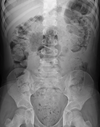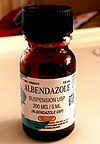Video:Hookworm infection
| Hookworm infection (Tutorial) | |
|---|---|
| Commons / NC | |
| Steps for video creation | |
| Step 1 | Preview my changes (10 sec) |
| Step 2 | Upload to Commons (10 min) |
Description
Hookworm infection is an infection by a type of intestinal parasite known as a hookworm.[1] Initially, itching and a rash may occur at the site of infection. Those only affected by a few worms may show no symptoms. Those infected by many worms may experience abdominal pain, diarrhea, weight loss, and tiredness.[2] Treatment is typically with the medications albendazole or mebendazole for one to three days.[3]

Presentation
No symptoms or signs are specific for hookworm infection, but they give rise to a combination of intestinal inflammation and progressive iron-deficiency anemia and protein deficiency. Coughing, wheezing, and fever sometimes result from severe infection. Indigestion, nausea, vomiting, constipation, and diarrhea can occur early or in later stages.[4][5][6][7]

Cause
Hookworm infections in humans include ancylostomiasis and necatoriasis. Ancylostomiasis is caused by Ancylostoma duodenale, which is the more common type found in the Middle East, North Africa, and India. Necatoriasis is caused by Necator americanus, the more common type in the Americas, sub-Saharan Africa, Southeast Asia, China, and Indonesia.[6][8][9]
Diagnosis
The evaluation of Hookworm infection is done via a stool sample, as it will be examined for hookworm eggs under a microscope.[10]

Prevention 1
School-based mass deworming programs have been the most popular strategy to address the issue of hookworm infection in children. School-based programs are extremely cost-effective as schools already have an available, extensive, and sustained infrastructure.[11]

Prevention 2
Improving sanitation facilities help reduce the possibility of hookworm infection by guaranteeing separation of human waste and human contact.[10]

Treatment
The most common treatment for hookworm infection are benzimidazoles, specifically albendazole and mebendazole. BZA kills adult worms by binding to the nematode's β-tubulin and subsequently inhibiting microtubule polymerization within the parasite.[12]

Epidemiology
In 2011 it was estimated that between 576 and 740 million individuals worldwide were infected with hookworm.[13]

History
Italian physician Angelo Dubini was the modern-day discoverer of the worm in 1838 after an autopsy of a woman. Dubini published details in 1843 and identified the species as A. duodenale. Working in the Egyptian medical system in 1852 German physician Theodor Bilharz, drawing upon the work of colleague Wilhelm Griesinger, found these worms during autopsies and went a step further in linking them to local endemic occurrences of chlorosis.[14]

References
- ↑ Prevention, CDC - Centers for Disease Control and. "CDC - Hookworm - Biology". www.cdc.gov. Archived from the original on 21 June 2017. Retrieved 21 June 2017.
- ↑ "CDC - Hookworm - General Information - Frequently Asked Questions (FAQs)". www.cdc.gov. 16 December 2014. Archived from the original on 22 April 2017. Retrieved 22 April 2017.
- ↑ "CDC - Hookworm - Treatment". www.cdc.gov. 10 January 2013. Archived from the original on 23 April 2017. Retrieved 22 April 2017.
- ↑ "Hookworm Infection - Infections - MSD Manual Consumer Version". MSD Manual Consumer Version. Archived from the original on 8 February 2024. Retrieved 2 May 2024.
- ↑ Loukas, Alex; Hotez, Peter J.; Diemert, David; Yazdanbakhsh, Maria; McCarthy, James S.; Correa-Oliveira, Rodrigo; Croese, John; Bethony, Jeffrey M. (8 December 2016). "Hookworm infection". Nature Reviews Disease Primers. 2 (1): 1–18. doi:10.1038/nrdp.2016.88. ISSN 2056-676X. PMID 27929101. Archived from the original on 26 February 2024. Retrieved 6 May 2024.
- ↑ 6.0 6.1 Ghodeif, Alhassan O.; Jain, Hanish (2024). "Hookworm". StatPearls. StatPearls Publishing.
- ↑ Brooker, Simon; Bethony, Jeffrey; Hotez, Peter J. (1 January 2004). "Human Hookworm Infection in the 21st Century". Advances in Parasitology. Academic Press. 58: 197–288.
- ↑ Aziz, Mochamad Helmi; Ramphul, Kamleshun (2024). "Ancylostoma". StatPearls. StatPearls Publishing. PMID 29939675. Archived from the original on 2024-04-28. Retrieved 2024-05-08.
- ↑ Hotez, Peter J.; Bethony, Jeff; Bottazzi, Maria Elena; Brooker, Simon; Buss, Paulo (29 March 2005). "Hookworm: "The Great Infection of Mankind"". PLOS Medicine. 2 (3): e67. doi:10.1371/journal.pmed.0020067. ISSN 1549-1676.
- ↑ 10.0 10.1 "About Hookworm". Parasites - Soil-transmitted helminths. 16 February 2024.
- ↑ "School Deworming". Public Health at a Glance. World Bank. 2003.
- ↑ Bethony J, Brooker S, Albonico M, Geiger SM, Loukas A, Diemert D, Hotez PJ (May 2006). "Soil-transmitted helminth infections: ascariasis, trichuriasis, and hookworm". Lancet. 367 (9521): 1521–32. doi:10.1016/S0140-6736(06)68653-4. PMID 16679166.
- ↑ Fenwick A (March 2012). "The global burden of neglected tropical diseases". Public Health. 126 (3): 233–6. doi:10.1016/j.puhe.2011.11.015. PMID 22325616.
- ↑ Cox, FE (October 2002). "History of human parasitology". Clinical Microbiology Reviews. 15 (4): 595–612. doi:10.1128/CMR.15.4.595-612.2002. PMC 126866. PMID 12364371.